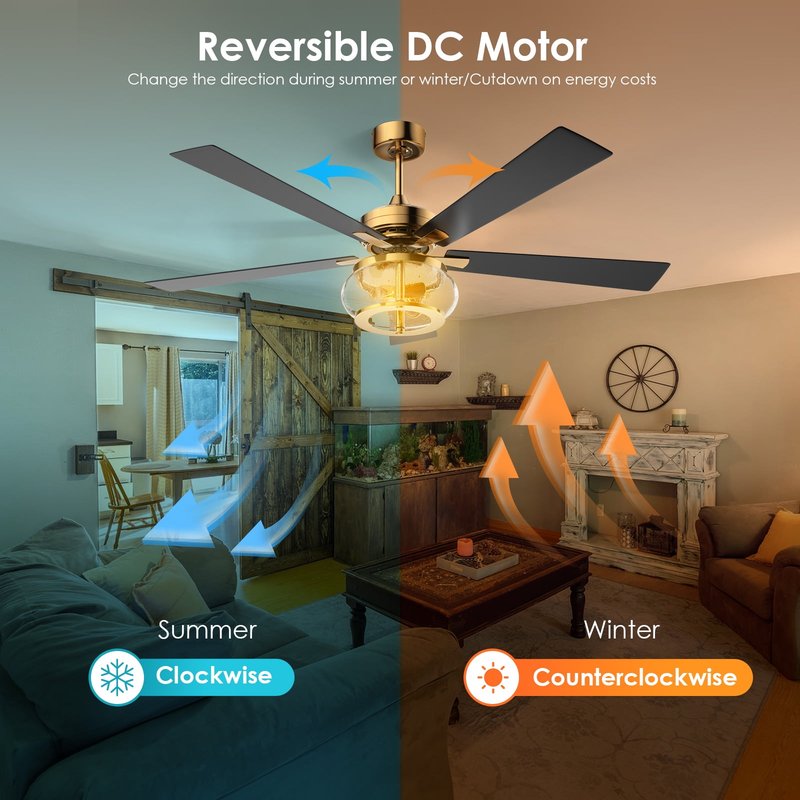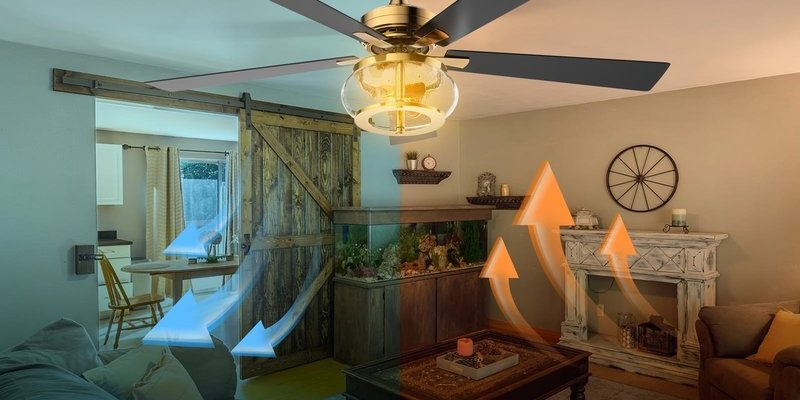
Now, if you’re holding a Westinghouse ceiling fan remote and feeling like it’s got more buttons than you know what to do with, don’t worry. You’re not alone. These remotes can look intimidating with their labeled (and sometimes unlabeled) switches. The trick is knowing which button controls the reverse mode, and what to do if things aren’t working as expected. Let’s break it down step by step, from understanding what reverse mode does, to exactly how to enable it, and what to do if the fan ignores your commands.
What Is Reverse Mode on a Westinghouse Ceiling Fan?
Here’s the thing: reverse mode is like flipping the direction of traffic on a one-way street. Instead of pushing air down for that cooling breeze in summer, the blades spin the other way, pulling air up. This simple tweak changes the airflow so that warm air (which naturally rises) gets pushed back down along the walls. That means your room feels warmer, without cranking up the thermostat.
Westinghouse ceiling fans with remotes often come with both forward and reverse modes built-in. The function is all about comfort and efficiency. In winter, the reverse mode can shave a few bucks off your heating bill by circulating heated air more evenly. In summer, you want the usual downward breeze to keep cool. It’s not about spinning faster or slower—it’s literally just the direction.
You might be wondering: “Does every Westinghouse remote have reverse mode?” Most modern ones do, but if you’re using an older remote or an aftermarket universal remote, things might look different. Some remotes have a dedicated “reverse” button, while others hide it under a function or mode switch. If your model doesn’t seem to have it, don’t panic—sometimes there’s a physical switch on the fan housing itself.
Understanding Your Westinghouse Ceiling Fan Remote Control
Let me explain how the typical Westinghouse remote works. Most Westinghouse ceiling fan remotes look like little TVs’ remotes, with buttons for power, speed (low, medium, high), light, and sometimes a couple of mysterious extras. For reverse mode, you’re looking for a button labeled “REV,” “Reverse,” or sometimes just an icon with two arrows circling.
Some remotes make it super obvious—tap the reverse button, and the fan changes direction. Others require a code or a press-and-hold. With a universal remote or after swapping remotes (think: lost original, got a replacement), the pairing process can sometimes scramble things. You might need to sync or reset your remote to make sure it’s talking to the fan correctly.
If you’ve recently changed the battery, or if your remote lost sync, try fresh batteries and re-pairing. Honestly, most connection issues with Westinghouse fan remotes boil down to low battery or a lost sync between remote and receiver. It’s worth double-checking before you dig into complicated troubleshooting.
Step-by-Step: How To Enable Reverse Mode With Westinghouse Ceiling Fan Remote
Ready to flip your fan into reverse? Here’s a slow walk through the steps, as if you’re showing a friend for the first time.
- 1. Turn Off the Fan — Make sure your fan is off and stopped completely before changing direction. This avoids unnecessary strain on the motor.
- 2. Identify the Reverse Button — Find the “Reverse” or “REV” button on your Westinghouse remote. Sometimes, it’s just an icon with a two-way arrow. On certain models, it’s bundled with a function or mode button.
- 3. Press the Reverse Button — Give the button a firm press. If your remote is working properly and paired, you’ll hear a soft click from the fan or see the blades start to slow, pause, then restart in the opposite direction.
- 4. Turn the Fan Back On — Select your desired speed, and you’re good to go. In reverse mode, airflow may feel subtler—it’s meant for gentle air mixing in winter, not for a breezy blast.
If pressing the button does nothing, don’t panic. Some remotes require you to hold the reverse button for a few seconds, or press another button simultaneously (like “Fan” + “Reverse”). Check your model’s manual if you’re stumped.
One tiny story here: I once spent fifteen minutes jabbing desperately at the reverse button, only to realize the batteries were dead. A quick swap, and suddenly the fan was doing its winter “updraft” thing like a champ.
Troubleshooting: Reverse Mode Not Working on Westinghouse Fan
You might be staring at your fan after a few tries and thinking, “Am I missing something?” Here are some common issues, with fixes that usually work:
- Dead or Weak Battery in Remote — This catches more people than you’d think. Swap in a fresh battery, then try again.
- Remote Not Paired — If the fan isn’t responding at all, it could be a sync or pairing issue. Check your manual for pairing instructions—it usually involves holding down a set of buttons until the fan beeps or the light blinks.
- Physical Reverse Switch — Some Westinghouse fans (especially older or entry-level models) still have a physical reverse switch on the fan’s motor housing. Look for a tiny black or white sliding switch. If your remote seems useless, try flipping this switch while the fan is off.
- Obstructions or Signal Interference — Make sure nothing’s blocking the signal between your remote and the fan receiver. Some electronics (like routers) can cause weird interference, too.
- Wiring or Receiver Problems — If nothing works and your fan just ignores every command, it might be a wiring or receiver issue. At that point, unless you’re handy with code or electronics, it’s worth calling in a pro.
Here’s an insight: Most problems are easy fixes if you start with the basics—battery, pairing, and making sure you’ve actually got a model that supports reverse by remote.
Where Is the Reverse Button on My Westinghouse Ceiling Fan Remote?
This question comes up a lot, and honestly, it depends on your exact remote model.
- Dedicated Reverse Button: Some newer remotes give you a clearly labeled button (REV or Reverse), usually smack in the middle or near the bottom.
- Multi-Function/Mode Button: On combo remotes, you might need to press the “Mode” or “Function” button to cycle through options until reverse mode activates.
- Hidden or Combined: With universal remotes, the reverse function is sometimes a press-and-hold or a combo (like holding “Fan” + “Light” together for 5 seconds).
If you can’t find a reverse button, double-check your model’s code sheet or manual. Some remotes use icons only—like a little circle with arrows—so don’t overlook strange symbols.
Comparing Universal Remotes vs. Westinghouse Original Remote
You might be tempted to pick up a cheap universal remote if you lose or break your original. But here’s the deal: not all universal remotes support reverse mode on every fan. The original Westinghouse remote is guaranteed to work with all the built-in features, including reverse, syncing, and light dimming.
Universal remotes can sometimes control basic functions (on/off, speed, light), but may skip special modes like reverse or code syncing. If you’re thinking of going universal, double-check the box or online listing for a mention of “reverse mode” compatibility. Otherwise, you might find yourself stuck in the wrong direction for half the year.
If your fan came with a wall-mounted remote, reverse might require a special sequence—or it could be only accessible with the original remote. Swapping between universal and original remotes sometimes means re-pairing or resetting the code, so keep your instructions handy.
Tips for Safe Use and Maintenance of Your Remote
Taking good care of your Westinghouse ceiling fan remote goes a long way toward hassle-free use. Here are a few practical tips:
- Replace Batteries Regularly — Low batteries lead to weak signals, missed commands, or total remote failure. If things get finicky, swap in new batteries first.
- Keep It Clean and Dry — Moisture is the enemy of electronics. Wipe down your remote if it gets sticky and avoid using it with wet hands.
- Store It Safely — If your remote comes with a wall holder, use it. Remotes that lounge around on couches or tables are magnets for getting lost—or worse, stepped on.
- Re-Sync After Power Loss — Sometimes, a power outage or button mash-fest can throw off the remote’s code. Follow your manual’s instructions to reset or pair your remote if things get weird.
A little routine care means you’ll spend less time hunting for missing remotes or battling stubborn buttons and more time actually enjoying your fan.
How Reverse Mode Affects Airflow and Comfort
Why bother switching to reverse mode anyway? Here’s where physics gets cozy. In the summer, your Westinghouse ceiling fan in forward mode pushes cool air down, giving you immediate relief. In winter, switching to reverse mode gently pulls cool air up, which in turn nudges the warm air stuck near the ceiling back down along the walls.
The effect is subtle—you won’t feel a breeze, but you *will* notice your room’s overall temperature stays more consistent and comfortable. This is especially helpful for rooms with high ceilings, where hot air tends to gather way above your head. Using reverse mode might even help lower your energy bills, because your heater doesn’t have to work as hard.
Honestly, once you’ve tried it a few times, switching between modes becomes second nature. It’s like knowing when to swap your wardrobe for the season—you just get it.
If you’ve ever wondered what all those extra buttons on your Westinghouse ceiling fan remote actually do, reverse mode is one of the best hidden gems. With just a few steps—and maybe a new battery or quick sync—you can make your fan work harder for you, year-round. Even if the process feels a bit mysterious at first, once you’ve flipped that direction switch a couple of times, it’ll be as easy as changing the channel.
Every little feature is there to make your home more comfortable. Take a minute now and then to check the batteries and give that remote a little TLC. Before you know it, you’ll be the person in your friend group who actually *knows* what the reverse button does—and why it matters, whether it’s hot or cold outside.
